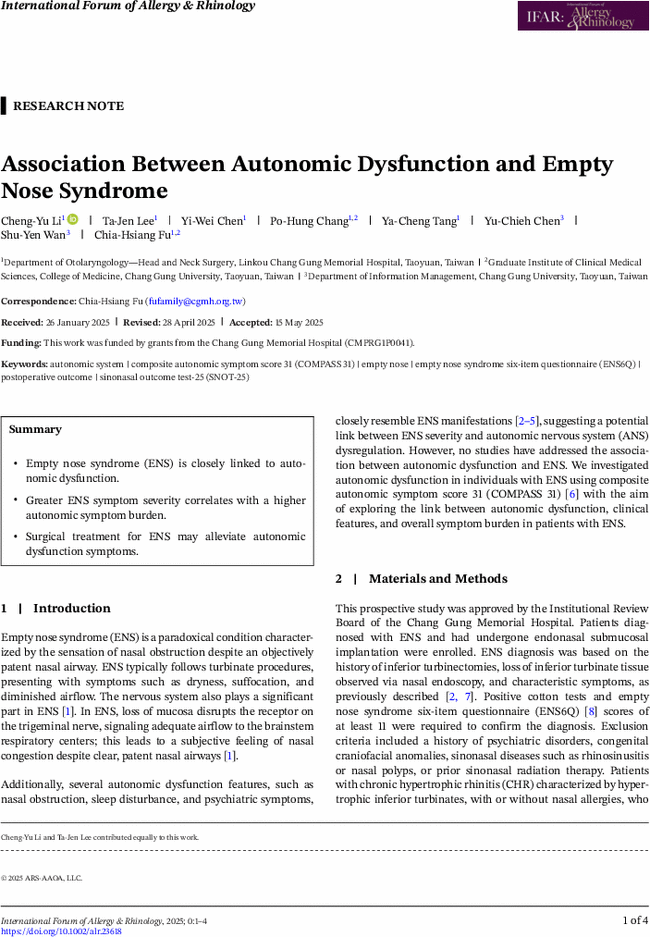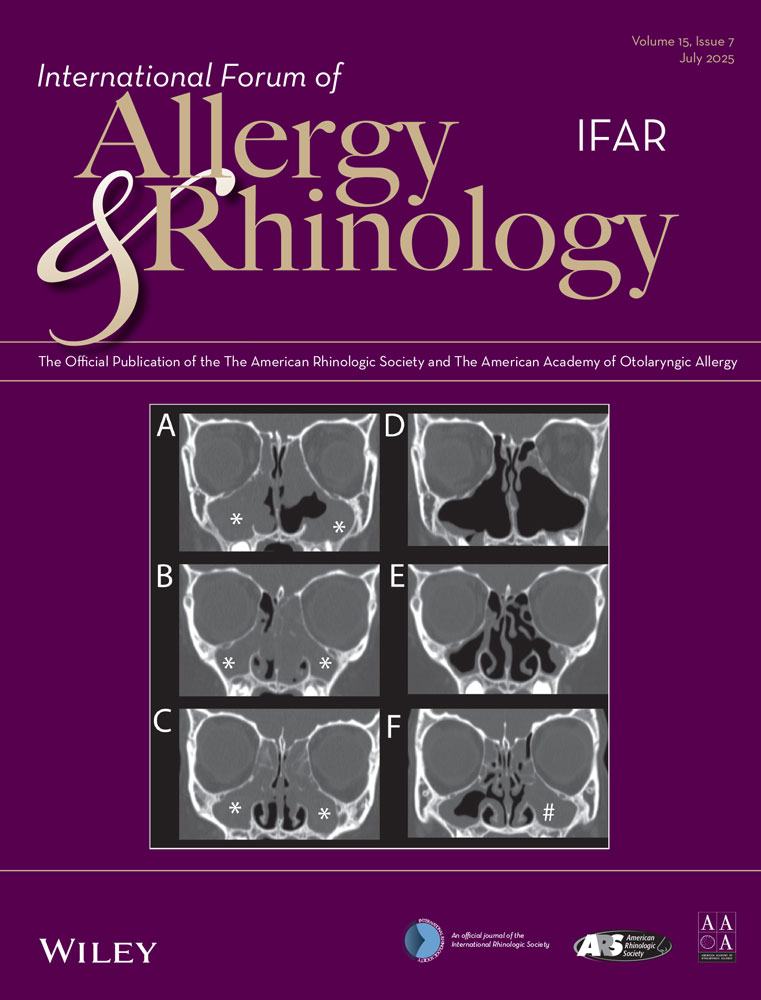Association Between Autonomic Dysfunction and Empty Nose Syndrome
Cheng-Yu Li
Department of Otolaryngology—Head and Neck Surgery, Linkou Chang Gung Memorial Hospital, Taoyuan, Taiwan
Search for more papers by this authorTa-Jen Lee
Department of Otolaryngology—Head and Neck Surgery, Linkou Chang Gung Memorial Hospital, Taoyuan, Taiwan
Search for more papers by this authorYi-Wei Chen
Department of Otolaryngology—Head and Neck Surgery, Linkou Chang Gung Memorial Hospital, Taoyuan, Taiwan
Search for more papers by this authorPo-Hung Chang
Department of Otolaryngology—Head and Neck Surgery, Linkou Chang Gung Memorial Hospital, Taoyuan, Taiwan
Graduate Institute of Clinical Medical Sciences, College of Medicine, Chang Gung University, Taoyuan, Taiwan
Search for more papers by this authorYa-Cheng Tang
Department of Otolaryngology—Head and Neck Surgery, Linkou Chang Gung Memorial Hospital, Taoyuan, Taiwan
Search for more papers by this authorYu-Chieh Chen
Department of Information Management, Chang Gung University, Taoyuan, Taiwan
Search for more papers by this authorShu-Yen Wan
Department of Information Management, Chang Gung University, Taoyuan, Taiwan
Search for more papers by this authorCorresponding Author
Chia-Hsiang Fu
Department of Otolaryngology—Head and Neck Surgery, Linkou Chang Gung Memorial Hospital, Taoyuan, Taiwan
Graduate Institute of Clinical Medical Sciences, College of Medicine, Chang Gung University, Taoyuan, Taiwan
Search for more papers by this authorCheng-Yu Li
Department of Otolaryngology—Head and Neck Surgery, Linkou Chang Gung Memorial Hospital, Taoyuan, Taiwan
Search for more papers by this authorTa-Jen Lee
Department of Otolaryngology—Head and Neck Surgery, Linkou Chang Gung Memorial Hospital, Taoyuan, Taiwan
Search for more papers by this authorYi-Wei Chen
Department of Otolaryngology—Head and Neck Surgery, Linkou Chang Gung Memorial Hospital, Taoyuan, Taiwan
Search for more papers by this authorPo-Hung Chang
Department of Otolaryngology—Head and Neck Surgery, Linkou Chang Gung Memorial Hospital, Taoyuan, Taiwan
Graduate Institute of Clinical Medical Sciences, College of Medicine, Chang Gung University, Taoyuan, Taiwan
Search for more papers by this authorYa-Cheng Tang
Department of Otolaryngology—Head and Neck Surgery, Linkou Chang Gung Memorial Hospital, Taoyuan, Taiwan
Search for more papers by this authorYu-Chieh Chen
Department of Information Management, Chang Gung University, Taoyuan, Taiwan
Search for more papers by this authorShu-Yen Wan
Department of Information Management, Chang Gung University, Taoyuan, Taiwan
Search for more papers by this authorCorresponding Author
Chia-Hsiang Fu
Department of Otolaryngology—Head and Neck Surgery, Linkou Chang Gung Memorial Hospital, Taoyuan, Taiwan
Graduate Institute of Clinical Medical Sciences, College of Medicine, Chang Gung University, Taoyuan, Taiwan
Search for more papers by this authorCheng-Yu Li and Ta-Jen Lee contributed equally to this work.
Funding: This work was funded by grants from the Chang Gung Memorial Hospital (CMPRG1P0041).

Conflicts of Interest
The authors declare no conflicts of interest.
References
- 1C. Li, A. A. Farag, G. Maza, et al., “Investigation of the Abnormal Nasal Aerodynamics and Trigeminal Functions Among Empty Nose Syndrome Patients,” International Forum of Allergy & Rhinology 8, no. 3 (2018): 444–452.
- 2N. Chhabra and S. M. Houser, “The Diagnosis and Management of Empty Nose Syndrome,” Otolaryngologic Clinics of North America 42, no. 2 (2009): 311–330.
- 3A. Yao, J. A. Wilson, and S. L. Ball, “Autonomic Nervous System Dysfunction and Sinonasal Symptoms,” Allergy and Rhinology (Providence) 9 (2018): 2152656718764233.
- 4M. X. Hu, F. Lamers, E. J. de Geus, and B. W. Penninx, “Differential Autonomic Nervous System Reactivity in Depression and Anxiety During Stress Depending on Type of Stressor,” Psychosomatic Medicine 78, no. 5 (2016): 562–572.
- 5C. C. Huang, P. W. Wu, C. H. Fu, et al., “What Drives Depression in Empty Nose Syndrome? A Sinonasal Outcome Test-25 Subdomain Analysis,” Rhinology 57, no. 6 (2019): 469–476.
- 6D. M. Sletten, G. A. Suarez, P. A. Low, J. Mandrekar, and W. Singer, “COMPASS 31: A Refined and Abbreviated Composite Autonomic Symptom Score,” Mayo Clinic Proceedings 87, no. 12 (2012): 1196–1201.
- 7E. C. Kuan, J. D. Suh, and M. B. Wang, “Empty Nose Syndrome,” Current Allergy and Asthma Reports 15, no. 1 (2015): 493.
- 8N. Velasquez, A. Thamboo, A. R. Habib, Z. Huang, and J. V. Nayak, “The Empty Nose Syndrome 6-Item Questionnaire (ENS6Q): A Validated 6-Item Questionnaire as a Diagnostic Aid for Empty Nose Syndrome Patients,” International Forum of Allergy & Rhinology 7, no. 1 (2017): 64–71.
- 9G. Liccardi, A. Salzillo, L. Calzetta, et al., “Can Bronchial Asthma With an Highly Prevalent Airway (and systemic) Vagal Tone be Considered an Independent Asthma Phenotype? Possible Role of Anticholinergics,” Respiratory Medicine 117 (2016): 150–153.
- 10M. Hagins, M. Pietrek, A. Sheikhzadeh, M. Nordin, and K. Axen, “The Effects of Breath Control on Intra-Abdominal Pressure During Lifting Tasks,” Spine (Phila Pa 1976) 29, no. 4 (2004): 464–469.




